Introduction

In the film era a vast amount of filters was needed to alter the colours, the temperature or to add certain effects to the photos. In digital photography many of these filters have become pretty much useless as they can be recreated in post processing with the added bonus of more control over the effect without any disadvantages.
But there are also some useful filters which can’t be fully recreated in post processing and still have a place in digital photography and these are the ones I’m going to talk about.
Update 09/27/2016: at Photokina 2016 in Cologne I checked out all the big filter manufacturers and have updated some sections accordingly. I am also working closely with NiSi filters now – not just because I think their filters offer the best quality – but because they listen to their customers and I hope to be able to help them develope the first holder I find nothing to complain about 🙂
Polarizer

The polarizer is by far the most powerful filter out there. It can affect polarized light in the ways of strengthen or weaken it. This may sound a little cryptic, but I will try to give some examples what that means in practice.
Reflections and the sky
Both shots were taken with the exact same camera settings and have undergone the same post processing, only the polarizer setting is different.
Reflections mainly consist of polarized light, so a polarzier has great effect on these. Furthermore you may also change the appearance of the sky by using this filter. Polarizers only work (well) at certain angles, so standing directly in front of a shop window you will have a hard time eliminating any reflections. Stay there about 30° to the window and you may be better off. Rainbows also consist of polarized light, so you can either emphasize or eliminate them.
With ultra wide angle lenses you may also run into some problems as the field of view of these lenses is so great that the polarzier might show different effects in different parts of the image.
Wet foliage
The ability to eliminate the reflections on wet foliage and rocks is invaluable for me in nature and landscape photography. Without the reflections photos look way more saturated and clean.
In this photo I used the polarzier to eliminate the reflections of light on the wet rocks and also the reflections on the water, so the stones beneath surfaced and made the photo way more interesting:
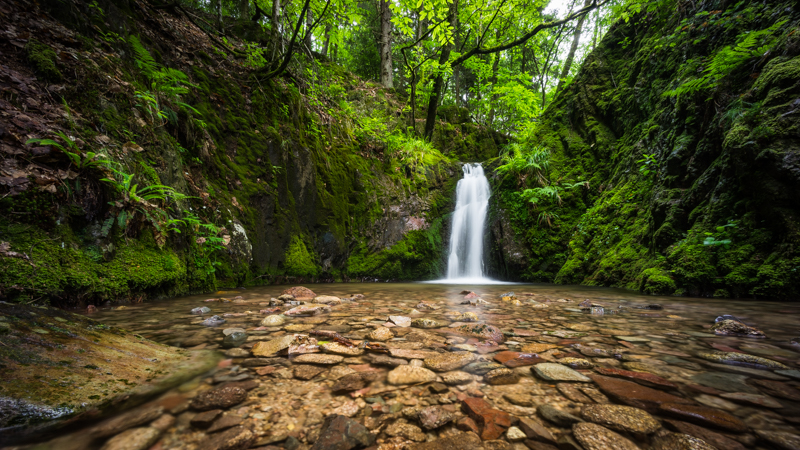
You shouldn’t chimp on a polarizer. As the good ones are quite expensive it may be a good idea to buy one for the lens with the biggest filter diameter and use in on the other lenses with step-up rings. I can recommend the Hoya HD Polarizers*, which I have used for many years now.
Update: There are also manufactures like NiSi or Singh-Ray now offering “Landscape” or “Warming” polarizers, which have some additional effects on certain colors. I will try to get my hands on one of these and post a comparison here as soon as possible.
Neutral Density Filters (ND)
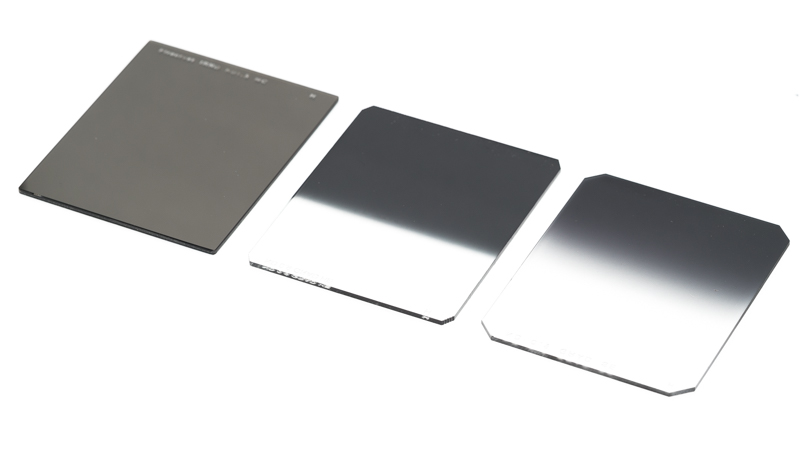
Neutral density filters give the ability to use longer exposure times during daylight. This is effective for shooting waterfalls which will turn into mist or clouds to create the impression of movement in the sky. These filters come in different intensities ranging from 0.3 Stops to 15 Stops and even more. The most common I use are 6 and 10 stop ND filters.
Update: almost every manufacturer is now also offering stronger ND filters: Lee a “Super Stopper” 15-stop ND* filter (exposure time x32.000), Hitech the Firecrest 13* (x8.000) and 16-Stop* (x64.000) ND filters and NiSi a 15-stop* and the “Black Hole” 20-stop ND* filter, the latter increasing your exposure time by the whopping factor of 1.000.000 (2^20) which will only be useful in real bright environments, as a 1 second exposure will become a 12 day(!) exposure. It can be used to shoot landscapes wide open with a long exposure time under very sunny circumstances though.
Strong ND filters can also have a strong colour cast. When it comes to 10-Stop ND filters I have thoroughly used myself the Lee Big Stopper (100mm), the Hitech Firecrest 10-Stop ND Filter (67mm) and the NiSi 10-Stop Nano-coated ND Filter (70mm) which are all made of optical glass, not resin. The Lee filter has a very strong blue cast, which can be corrected in post, but your images will look very blue on the camera display. The NiSi and the Hitech filters show almost no color cast but the Hitech filter unfortunately lacks a foaming to prevent straylight getting in between holder and filter (this seems to be only true for the 67mm system thoug, the 100mm Hitech Firecrest series seems to feature such foaming).
*affiliate links
For the following shot I used a 10 Stop ND filter (the Lee Big Stopper*) which leads to a 1000 (2^10=1024) times longer exposure:
Nowadays you can also buy so called “Vario ND Filters” where you can change the density. This sounds like a good idea at first sight but I would strongly advise to avoid these things (except for maybe filming). They consist of two contorted polarizers so you might encounter the effect of a polarizer which you can’t control (and may not even want) and setting a distinct density value is next to impossible.
Graduated Neutral Density Filters (GND)
These filters have a gradient and come in the types of Soft Edge, Hard Edge and Reverse and also have different densities. Even with the high dynamic range of modern cameras sometimes a GND filter makes sense, just take a look at the title photo with the blown out sky.
In the following example I first took a shot without a GND, the sky is blown out in many areas. To balance the exposure I used a 3 Stop (0.9) Soft Edge GND filter:
For starters I would recommend getting a 0.9 Hard Edge and a 0.9 Soft Edge GND filter*. This gives you quite a lot of options without spending much money on not needed filters. Especially stay away from sets which include 0.3, 0.6 and 0.9 GND filters. The 0.3 is utterly useless, you can correct these small amounts in post.
Slot-in filters or Screw-in filters?

Most common are the screw in filters. For polarizers and ND filters these work quite ok, in case you want to use GND filters better invest in a slot-in filtersystem, as you want to be able to move the horizontal line with these.
A few years ago slot-in filtersystem were really quite expensive, luckily there are some more (decent) manufacturers now so you have more options than I did. You also need adapterrings for mounting the filtersystem first. These rings have to fit your lenses’ filter diameter.
So in case you are interested in a slot-in filtersystems read on.
Which is the right size for a Slot-in filter system?
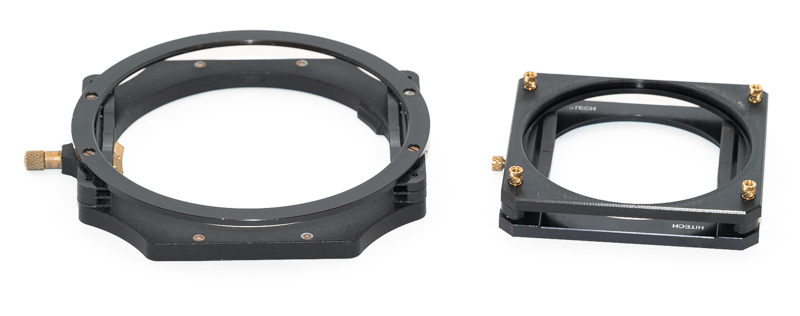
First you have to decide which size is the right one for you and your lenses, as these slot-in filter systems come in different sizes:
67 mm (Hitech, Cokin A)
70 mm (NiSi)
75 mm (Lee Seven5, Haida 75mm)
85 mm (Hitech, Cokin P)
100 mm (Lee 100mm, NiSi 100mm, Hitech, Cokin Z, Haida, Singh-Ray)
145 mm (Fotodiox Wonderpana)
150 mm (Lee SW150, Haida, NiSi 150mm)
165 mm (Hitech Lucroit)
180 mm (NiSi, to use Canons 11-24mm 4.0L at 11mm without vignetting)
There are probably some more and of course I haven’t used all of them myself (but seen many while holding workshops).
In case you want to use filters with lenses like the Nikon 14-24mm 2.8G, Samyang 14mm 2.8 and Tamron 15-30mm 2.8 you need 145 mm or more. To use Canons 11-24mm 4.0L black cornes due to the filter holder you even need a huge 180mm syste.
For other full frame lenses (including something like a 16-35mm 4.0) a 100 mm system will suffice.
In case you don’t need filters for your ultra wide angle lenses or you are using smaller lenses like the Zeiss Loxias oder Leica-M lenses even one of the smaller systems will do the job.
Are there any other differences?
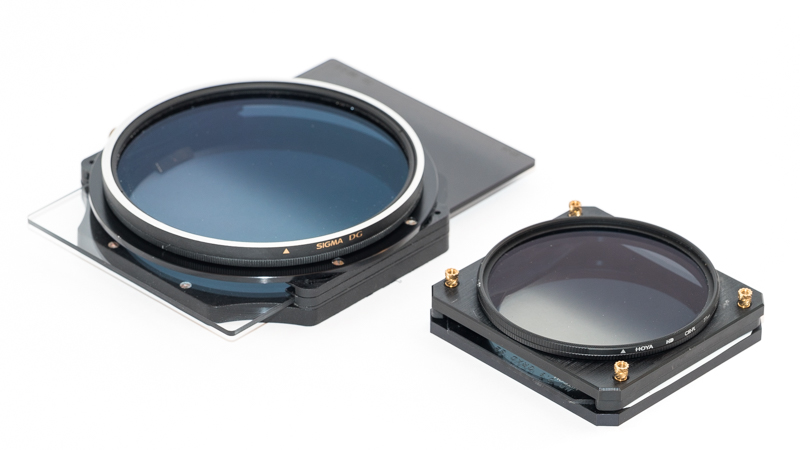
One of the major differences is the incorporation of the polarizer. With the Lee System you can either buy a 100 mm slot-in polarizer or mount an 105mm polarizer in front of the slot-in filters. Both options have their pro’s and con’s:
The slot-in polarizer can even be used with some 12-16mm lenses without vignetting issues but you can’t turn GND filters and the polarizer independently. With a polarizer up front you can do that but will probably encounter black corners due to vignetting with lenses wider than 21-24mm.
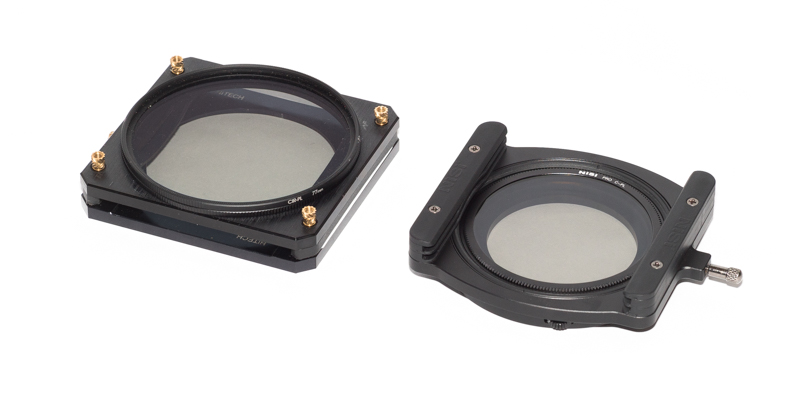
The NiSi V5 100mm and the 70mm system as well as the overhauled Haida 100mm System all incorporate a very slim polarizer between the lens and the slot-in filters. Both manufacturers implemented a little wheel to turn the polarizer even when mounted alongside square filters.
Hitech now uses a similar mechanism in their new 100mm Firecrest holder, but I found it to consist of too many, mostly plastic parts.
There are also differences when it comes to the quality of the filters. Resin scrachtes more easily than glass but is less prone to break.
When it comes to GND filters there are solid-colored filters and filters with just a very thin dark surface. If the latter caught a scratch it becomes pretty much useless.
The Cokin filters often show nasty color shifting which is not even across the spectrum so can’t easily be corrected.
The Hitech filters (epecially the newer Firecrest series) are usually quite good, but combining 2 or more GND filters may lead to color shifts as well.
Update: I found that with my 67mm Resin Hitech GND I get nasty green color shifts in the corners when used on the Zeiss Loxia 21mm 2.8 (might happen on other wideangle lenses, too). The Hitech Firecrest GND made of optical glass don’t show this behaviour, but all seem to be one stop weaker than stated (many amazon reviews claimed it, nevertheless I bought a 0.9 GND which was in fact merely a measured 0.6 GND), this is one of the reasons I am now using the NiSi 70mm system personally.
Lee and Singh Ray are pretty good but also pretty expensive.
Haida filters have great value when it comes to ND filters but I have no experience with GND filters from this manufacturer.
What’s in my bag?
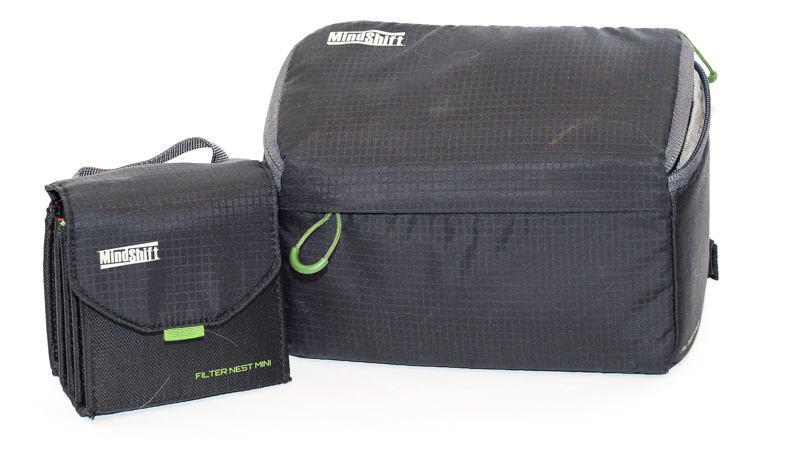
For my Nikon full frame DSLR lenses I was using the Lee 100mm System* which consists of a 105mm screw-in polarizer
*, a 100mm Lee slot-in polarizer
*, a 10-stop ND filter (Lee Big Stopper
)*, a Lee 0.9 GND Soft Edge
*, a Lee 0.9 GND Hard edge
* as well as an 0.6 Reverse GND by Hitech
* (which I rarely ever used) all stored in the MindShift Gear Filter Hive
*. As of today I might go for the NiSi V5 Holder* or the Haida Holder
* (which both offer a rotatable slim polarizer between lens and square filters) instead of the Lee Holder.
Update:
For my A7 cameras I was using the 67mm Hitech Holder*, a 77mm Hoya HD Polarizer
*, a 6-stop Firecrest glass ND, and a 0.9 Soft Edge GND
* as well as a 0.9 Hard Edge GND
* which fits all together in the great Mindshift Gear Filter Nest Mini
*.
(see reasons above why I am not using this setup anymore)
For my A7 cameras I am now using the 70mm NiSi holder* (which already includes a polarizer), 6-stop and 10-stop* nano-coated NiSi ND filters and my beloved 0.9 Soft Edge GND* as well as 0.9 Hard Edge GND*. To have some more space I also settled for the Lee Seven5 Pouch*.
With this setup I can use a polarizer in conjuction with a GND and ND with the Loxia 21mm 2.8 (if you turn the holder by ~45° you may get dark corners) as well as the Voigtlander 35mm 1.7 and 50mm 1.5, the Loxia 85mm 2.4 and even the Voigtlander SL 180mm 4.0 APO-Lanthar.
*affiliate links
For the Voigtlander 10mm 5.6 I now also have a lens specific 150mm holder (see review for more information). Due to it’s big size it is not something I carry around all the time, yet can yield astonishing results:
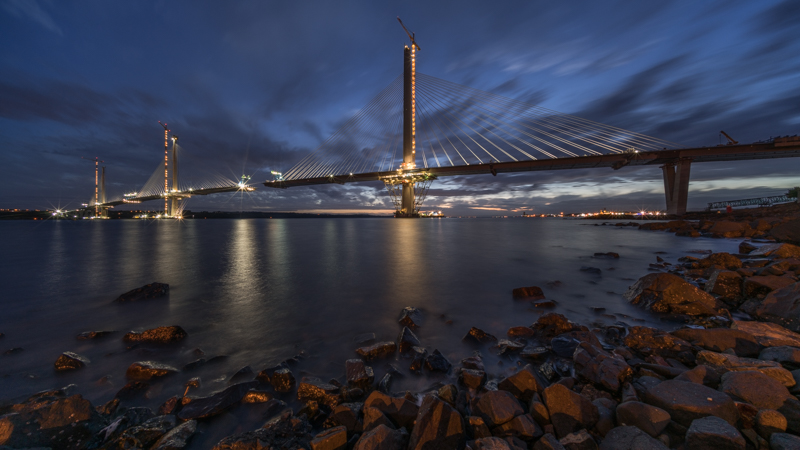
Sample images
Here you can find some of my photos where I used filters on flickr.
Further Reading
Support Us
Did you find this article useful or just liked reading it? Treat us to a coffee!
![]()
![]()
![]() via Paypal
via Paypal
This site contains affiliate links. If you make a purchase using any of the links marked as affiliate links, I may receive a small commission at no additional cost to you. This helps support the creation of future content.
Latest posts by BastianK (see all)
- Review: Sony FE 70-200mm 4.0 G Macro OSS II - December 20, 2025
- Review: Viltrox AF 35mm 1.2 FE LAB - December 17, 2025
- Analogue Adventures – Part 47: Tübingen - December 17, 2025
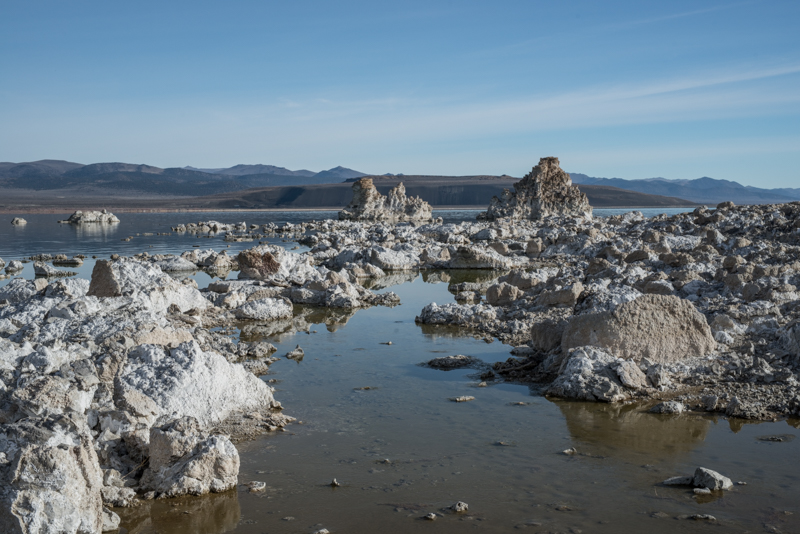
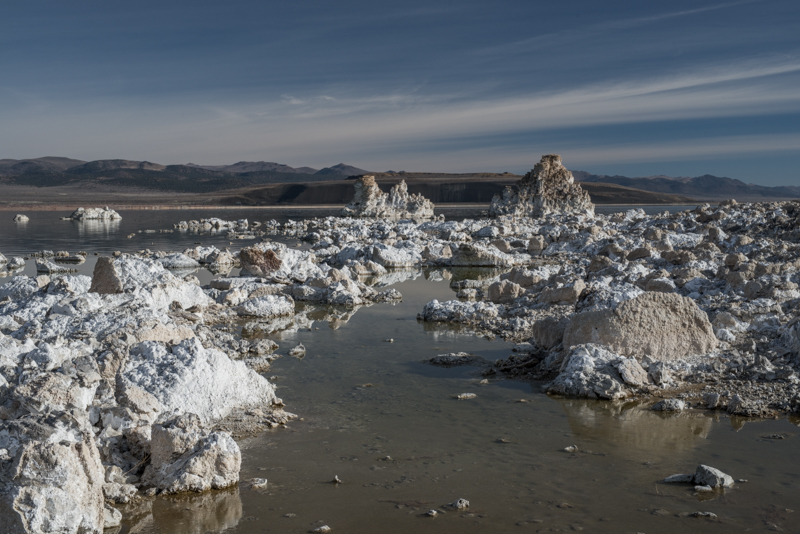




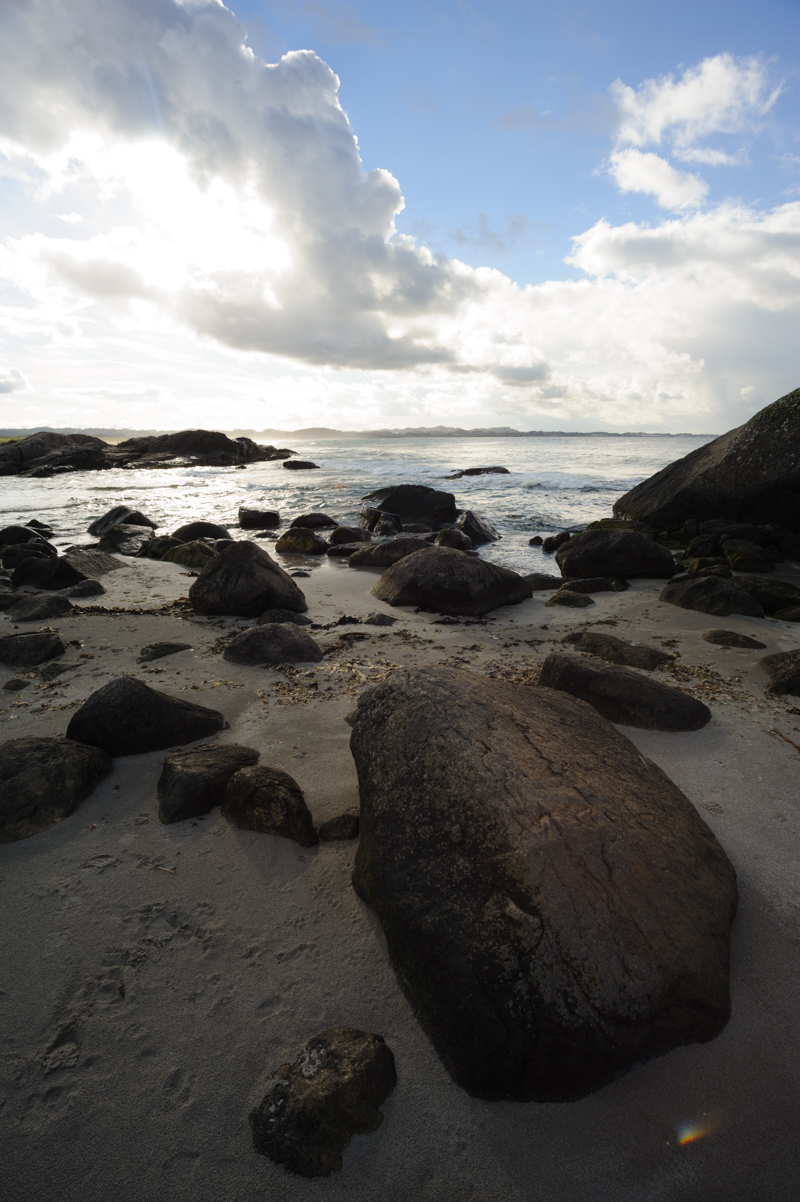
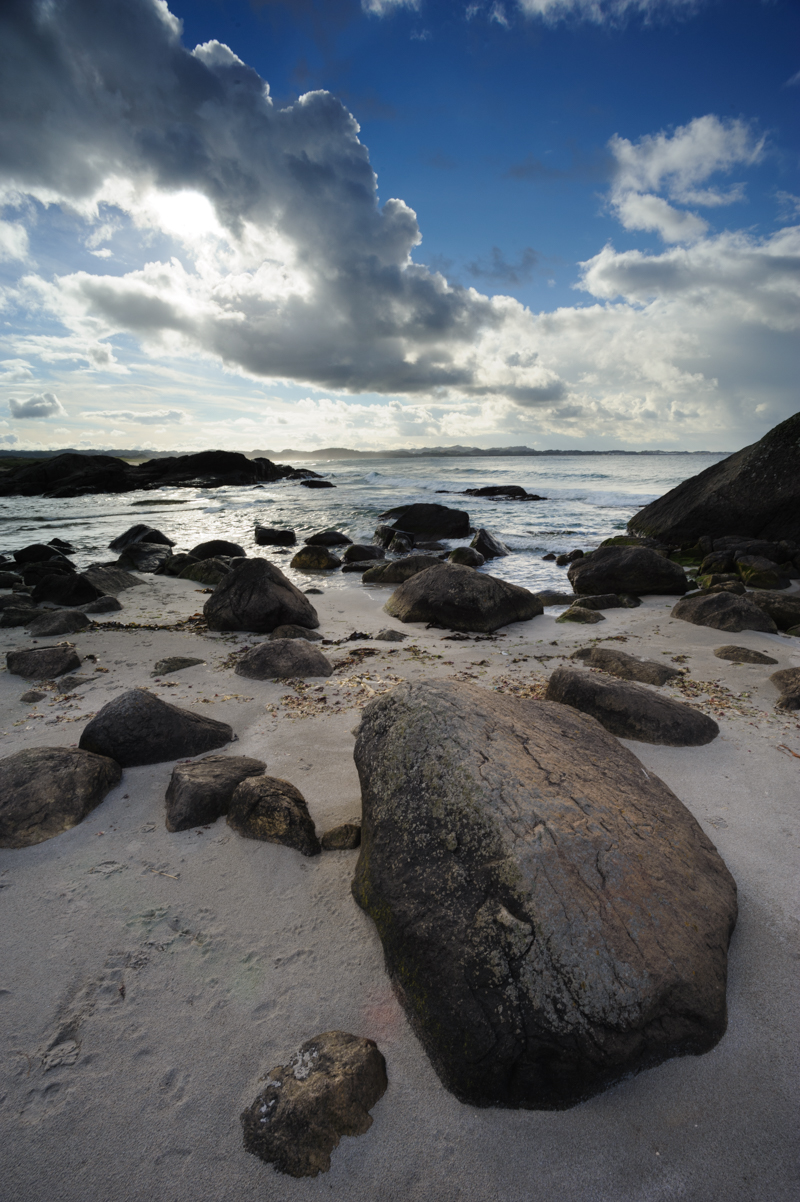
Hi Bastian,
Really nice article! I was looking into square filters as well.
Do you have more info how the 67mm set performs on your loxia 21mm? Any vignetting (when using the polarizer), color casts or sharpness reduction? Formatt hitech seems like a great manufacturer when it comes to price/quality, though I’m not sure if i I need a more high-end set of 100mm glass filters over the 67mm resin ones. I don’t plan to use it with lenses wider than the loxia.
Dear Cédric,
because of your question (and after I have seen some color casts due to filters on my recent trip) I decided to furher investigate this, which I did today.
There is no additional vignetting (like black corners) when using the Hitech 67mm filter holder even with a Hoya HD Polarizer mounted up front (I actually had a hard time believing that myself 🙂 )
The polarizer does not introduce (noticeable) reduction of sharpness or color cast.
The graduated ND filters (as written above I have a 0.9 Soft Edge and a 0.9 Hard Edge manufactured by Hitech) are introducing some green color cast on the borders, a little more on the A7s than on the A7rII.
I also tested my 100mm graduated ND Lee filters in comparison then, which also lead to green color cast on the borders to a similar degree.
So guided by this comparison I see no reason to use or buy more expensive and bulkier 100mm filters for the 21mm Loxia.
I hope I could help!
Bastian
Hi, I like the article. I’ve recently bought a hitech square filter system and the first time I put it on I realized that the lens caps don’t fit. Do you have a solution for that?
Many thanks in advance,
Flo
To be honest I don’t use lenscaps for any of my lenses at all, as they slow me down shooting and changing lenses.
Nevertheless there is a Lee lenscap available that might fit: http://www.leefilters.com/index.php/camera-directory/camera-dir-list/category/lens-cap
Another type of filter is the didymium based ones like the Hoya Red intensifier. You can’t replicate this effect in photoshop because it removes very specific frequencies (mostly yellow) from the picture and once its on the sensor its impossible to differentiate between red and green combined yellow and pure spectrum yellow. It make greens greener and reds redder without affecting blue. However it will make skys bluer (as it removes the yellow haze from pollution) and can remove the orange light of low pressure sodium lamps from night photos. As a bonus it also corrects the yellow cast on incadecent lighting. Amazing once you’ve seen it work.
Hi, how are you?
I saw your review and buy the lens Zeiss 16-35 f / 4, I would now like to buy at least one filter for this lens.
Which one would you recommend? ND wanted one for daytime photography and quisas a polarized filter
You have to be more specific: what do you want to achieve? Blur water, blur clouds?
clouds to generally.
ND variables are good?
thanks!
i look this
http://www.ebay.com/itm/Hoya-72mm-Variable-Neutral-Density-ND3-ND400-ND-DSLR-Digital-Filter-A-72VDY-/331838927341?hash=item4d432431ed:g:QgwAAOSw3mpXG4Rk
is good?
As written above I would not recommend buying any of these.
For clouds to blur you also need a very strong (10-Stop) ND filter, the variable ND filters are not that strong.
Hi Bastien,
Excellent article!!
I’m looking a filter system for the samyang 12mm (for aps-c) with sony a6000 and this 67mm system is so tempting. The problem is that I can’t find if there is problem with vignetting.
Any suggestion?
Dear Alex,
A 67mm System will be to small for your lens.
67mm means here the filters have a width of 67mm, the maximum diameter you can use with this system is 62mm.
You might want to try the Lee Seven5 System, they are not much bigger but compatible to diameters up to 72mm.
As the 12mm 2.0 is a very wide lens you might even need an 85mm System (like Formatt-Hitech).
Thanks for the answer Bastian!!
I believe hitech 85mm system it’s safer solution (the bad is double the price of the 67mm system). I see also the nisi 70mm system, but its for lenses with a maximum thread of 58mm.
You mention at “Photokina Highlights” about haida 75mm system. Any info about this system?
They don’t seem to have a real homepage, but according to their facebook page the system is only usable for lenses up to 58 mm.
Thanks for the info Bastian!!!
Hi Bastian,
thanks for your informative article. I’m going to buy a filter system for my trip to Italy in the summer. I’d really like to know more about the performance of Haida 100x150mm (Pro II MC) filters compared to the others you’ve already tested. From what I’ve gathered so far, they seem to be among the best you can buy and that at a fairly low pricepoint (it pains me to write low, though).
Is there any chance you will be able to test those in the near future? Maybe even compare the “old” to the new improved “2016” version? Also interesting seem to be the Rollei Filters (if they are not the same as the Haida – both introduced fairly late into the market, both made from Schott glass), but they are a little more expensive.
A few more general questions:
For starters I would get a GND 0.9 (soft) and a Reverse GND 1.2 (hard) plus the filter holder and the polarizer. In your opinion: Is that enough to cover most situations?
I have a good polarizer screw on filter and also a few ND srew ons. Would you recommend to replace those by the equivalent filters of a square system or will that not be worth it. I suspect it to be quite time consuming to handle both types of filters at the same time. Also vignetting will very likely be a problem if you stack the polarizer and ND screw on plus the 0.9 GND. Possible color shift problems, I suppose will occur with either system if you stack too many filters.
Thanks in advance, Rolf
Dear Rolf,
I haven’t tried the new Haida filters, only their holder at Photokina and I didn’t like it very much (final production model might be better though).
I would not buy the Rollei holder / filters. The holders are blatant copies of the NiSi products and I also compared the polarizers of both their 100mm Systems; the Rollei filter had huge problems with reflections and glare, the NiSi didn’t show.
If you mostly live/shoot by the sea: get the Reverse GND.
Otherwise I think a combination of 0.9 GND Soft and Hard ist most flexible.
I don’t like the handling of step up rings so I would try replacing the screw in filters.
Otherwise there is a huge likelihood you will be unable to unscrew the polarizer from the adapter ring some day, happens during my workshops all the time.
Hi Bastian,
I bought the Nisi 70mm system and solar I like it very much. Thanks for that!
I see you use the LeeSeven5 pouch for the filters. But how do you store the filter holder itself?
Thanks for your inspiration! Toon
Dear Toon, I am glad you like the filter system!
The Holder fits in that pouch as well in addition to the filters, I can send you a photo later the day if you are interested.
Yes! If you could do that? Would be great.
I thought others might find this helpful as well, so I am posting the photo here, I hope you don’t mind!
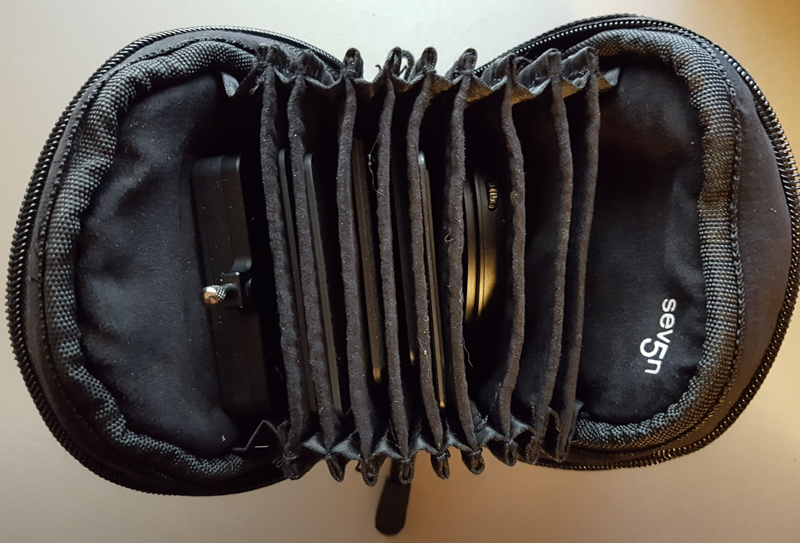
From left to right: 70mm holder (first slot is slightly wider), 5 filters, polarizer adapter, 2 empty slots, cleaning cloth:
Bastian,
Thank you for your through review. I am quite interested for Nisi 70mm system as well. Do you know if Nisi also makes 70mm natural light filter? I can only find 100mm or bigger one here. Also, PocketPANO seems quite interesting. Do you know where I could order that internationally by chance?
Dear Joon,
unfortunately NiSi is not making the Natural Night filter for the 70mm system (afaik).
Personally I am using the 77mm screw in, as I can also use it on my Laowa 15mm 2.0.
The inventor of the PocketPANO has not yet translated the homepage,
you can contact him via E-mail, I am sure he will assist: info@pocketpano.de
Thank you for your info. Your post got me into Loxia 21 in exchange of 16-35GM. As 35.4 and 85.4 are my major ones to use, I found Loxia 21 more attractive in my setup for its size and sunstar! so do you use a natural night filter on Loxia 21? I saw NiSi 52mm circular natural night filter from eBay but I wasnt sure it was legit.
I am using the 77mm screw in with a 52->77 step up adapter.
At the time I got it there was only 77mm available and as I wanted to use it on Laowa 2/15 as well I was quite fine with it.
For me that PocketPANO adapter coupled with Loxia 21mm 2.8 also solved two of my problems:
I have a wider than 21mm with (better than) Loxia quality and I can keep using my small 70mm filters.
Thank you for your comments Bastian. I’m getting PocketPANO as well! Did XL version work out better for you?
As I have an L-bracket attached to the camera all the time the XL version was better for me, yes.
The difference between normal and XL is only about 1 cm afaik, so it sounds much bulkier than it actually is 🙂
Great review on the PocketPano! Can I ask which 70mm filter system you are using?
Thank you!
I am using the NiSi 70mm M1 system.
If you are in the market for one I would recommend to wait for their new 75mm system which they just announced at Photokina and should be available soon.
Thank you for the heads up about the new Nisi filter system. I haven’t seen it reported anywhere else. Compatibility with 67mm lenses would be a great benefit/
Hello Bastian,
Would like to ask if you already had the chance to try out the new Nisi M75 filter system, as I am looking at their Landscape sets and find them very interesting – they would work fine with the CV 21mm and 40mm but how about the CV15 that wouldn`t work because of the petal hood of the lens, right, but without the hood petal if you were to cutt it of, would this filter sistem cause vigneting?
Cheese, Aleksander
I have a NiSi M75 system but unfortunately no 15mm 4.5 with cut off hood.
Some people had good experience with using the Lee Seven5 system so my guess is the NiSi will work just as well if not better, as the NiSi holder is a smarter design.
Thanks for your reply, good to hear it’s a good design, working well with cv lenses, if I recall correctly you have a 1gen cv 12mm, any way to make these nisi filters work there? Asking because I too don’t have a cv 15mm but I am looking for when something nice in the cv uww range becomes available so 10,12 and 15 are all on my radar with 15 beeing the 1st choise because it has at least a possibility to use screw in filters…
Cheers, A.
There is a gen2 12mm 5.6 (M-mount, not M39) which has a 67mm filter thread but also needs a hood to be cut off, this might work with the 75mm filter system, but I am not sure about that.
For the old M39 version (which I reviewed here) there is a 77mm filter adapter, so that won’t work.
Hi Bastian,
Is there an order or preference between ND filters and polarizer, such as which is closer to the lens. Also, do you know of screw-on polarizer that same time has a grove on it that one can mount the polarizer to the lens and then mount Lee system ring on the ploarizer
Thanks
Not really, either way works (Lee circular polarizer is farthest away from lens, other systems it is closest).
The setup your are thinking of, I don’t think it is advisable at all.
Maybe have a look at the NiSi V5/V5 pro/V6 holder instead, it is a way better design than the Lee holders as
it already incorporates a polarizer.
It should be compatible to your filters, so no need to buy new ones.
Hi Bastian,
thank you for the comprehensive review. May i bother you with several questions?
To achieve exposures of up to several minutes, 10 stop filters often are not sufficient. Do you prefer a 15 stop filter or the combination of a 10 and 6 stop, for example, in sich situations? When combining two filters, would you always go for the slot-in-system or is the screw-in-system suitable as well?
Furthermore, which system do you recommend, if I want to use it simultaneously on the Laowa 15mm (72 mm Filter Thread), the Sony 16-35 F4 (72mm) and the Sony 28mm F2 (49mm)?
Regards
Mathias
One 15 stop filter is better than 10 and 6 combined.
There is less chance of added reflections or color cast.
Generally I prefer slot in systems, makes focusing and framing a bit easier.
It is especially useful if you want to use a combination of polarizer and ND filter.
For these lenses you need a 100mm slot-in system.
Get a NiSi or similar one with polarizer close to the lens to not get vignetting with
the 16-35mm or 15mm if you want to use a polarizer.
Thanks a lot!!!
Very informative article, thank you! I’d like to mention that with C-PL filter one may want to purchase the screw-on hood of proper size, as it makes the filter a lot easier to rotate. And also the stock hood is often cannot be used in combo with CPL filter (impossible to rotate filter regardless of hood position, normal or reverse).
I really like B+W CPL KSM filters – expensive, but their light transmission is excellent (about 0.5 EV is lost), so I simply keep the filter on the lens when I’m outdoors in daytime.
Hi Bastian,
thank you for the review.
I have a NiSi M75 system on the Loxia 21 mm 2,8 .
Is it possible to use M75 system /polarizer, ND64, ND1000, reverse 0.9, soft 0.6/ on the Sony 16-35 F4 (72mm) with step down ring 72-67mm is required and a 67-67mm extender ring without vignetting? Do you have any experience?
Thank you for your answer.
No experience with that lens, but I seriously doubt that it will work without black corners at the wide end.
Hi Bastian,
reading your nice and informative article I have got two stupid questions about GND filters. (Until now, I have used polarizers and ND filters only, so I have got no experience with GND filters.)
1) I use a 100 mm slot-in system (NiSi V5 pro). If I want to buy now a 0.9 Soft Edge GND and a 0.9 Hard Edge GND, should I buy them in 100×100 mm size, or would it be better to buy them in 100mm width and 150mm hight, in order to be able to place the gradation easily anywhere in the frame?
2) For taking photos of sunsets (I know, sunsets are kitsch, but sometimes friends ask me to take photos of sunsets), some people recommend to use reverse GND filters. According to your description, you normally use only a soft plus a hard edge GND filter, no reverse GND filters. How do you setup these filters to take a photo of a sunset?
Sorry for the stupid questions and thank you very much for your help!
OK, sorry if this was a stupid question ;–). I was somewhat confused by the photo showing *square* GND filters (its the file “2016/06/nd_gnd_filters.jpg”), so these seem to exist.
But elsewhere I see only 100x150mm GND filters mentioned for a 100mm filter system, and it seems logical to use them for free placement of the gradation, so I have bought a 100x150mm 0.9 soft edge GND and a 100x150mm 0.9 hard edge GND now and will learn to use them over the summer.
I still wonder about the sunset issue, and will try if I can apply here one of the two filers or should buy an additional reverse GND or horizon GND filter. Best regards!
The ones in the picture are not square, these are from Hitech’s 67mm system and here also the ND were rectangular.
In the beginning Hitech also used to use 100×125 GND, these may still be available on the used market but I would recommend not to buy these.
Ah, thank you for the explanation! So the perspective has fooled me to think that these filters were square.
Obrigado pelo artigo. Não consegui conexão entre o Imaging Edge Mobile e minha Sony a7II. Entrei em contato com a Sony do Brasil que me negou atendimento por minha camêra ter sido adquirida em outro país. Você conhece outro aplicativo de smatphone para disparo remoto que conecte com a Sony a7II ??
I am not using a phone to remote control the camera, but qdslrdashboard may be what you are looking for.
As I haven’t used it myself I cannot give any support for it.
Thank you for a great read.
Do you use clear UV filters to protect the front element of a lens?
I thought you had talked about that before but I could not find it when I searched for it.
I don’t do that as I find it unneccessary.
Thank you Bastian.
I do use them but it may be time for me to stop.
What is good for me is not neccessarily good for everyone else, if you feel more comfortable/happy with using them I don’t want to be standing in the way 🙂
Thank you. That is true 🙂
I have been happy with my UV filters but apparently they may degrade the image quality by placing another layer before the lens.
Some have said that removing the filter improves the optics so I might try removing it to see if it does indeed make a difference (the photographer is of course unlikely to be improved by this).